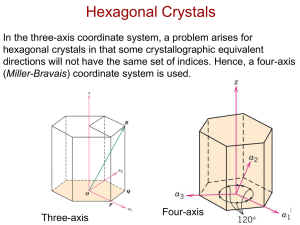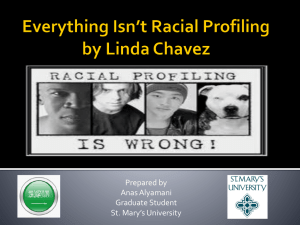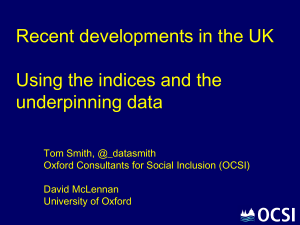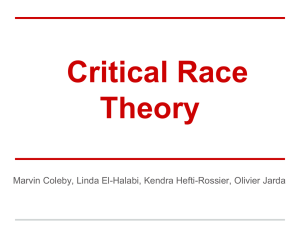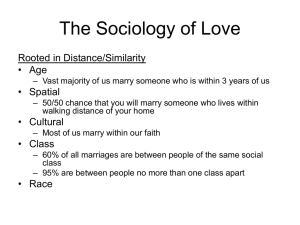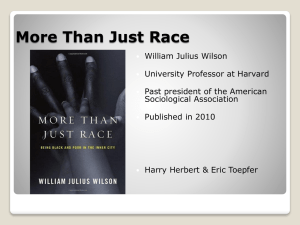Developing a Racial Diversity Index for CA
advertisement
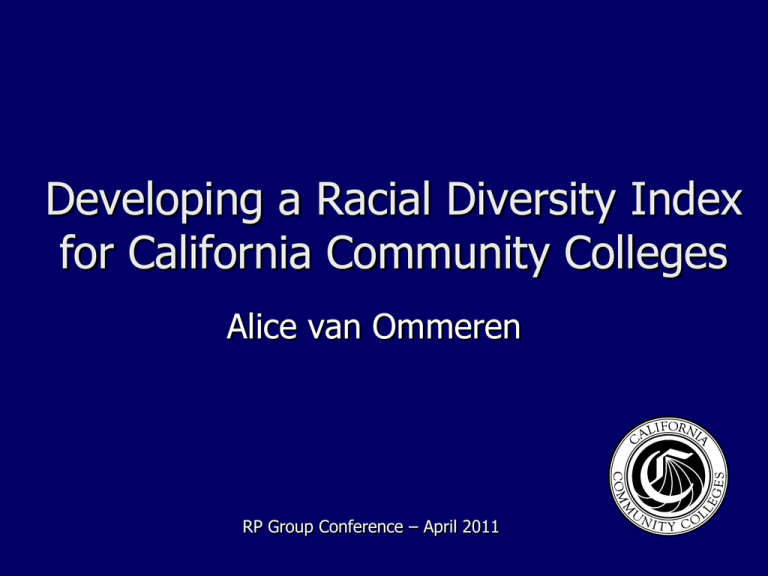
Developing a Racial Diversity Index for California Community Colleges Alice van Ommeren RP Group Conference – April 2011 Background Increasing attention to reducing the achievement gap (outcomes) Policymakers and administrators are inquiring about the racial disparities Researchers are being tasked to measure inequities and disparities Importance of capturing the racial diversity of the student body (access) Statement of the Problem Aware that we have a diverse system and been considerate in reporting Nature of the CCC’s racial composition has been relatively unexamined The relationship between student diversity as a covarariate or predictor variable has not been explored Purpose of the Study Examine the empirical nature of racial composition and diversity of the student population across the California community colleges Study Objectives Discuss types of diversity measures and relevant studies in higher education Develop racial diversity indices for each of the community colleges Describe the indices and potential use as adjustment variables Discuss application of the indices for researchers and policymakers Caution Racial categories are constructs and do not capture social, cultural, economic and political issues surrounding racial diversity General Methodology Datasets Early Racial Composition Measures Diversity Range and Variability Diversity Indices Analysis Exploratory Data Analysis Correlations and Scatterplots Specific Methodology Measures and indices for 111 colleges from Data Mart (Annual 2009-10) Removed 3 of the 9 categories (American Indian, 2 or more, unknown) Descriptives, also used histograms and boxplots to identify outliers Relationship among the diversity measures & indices Racial Composition Measures Percent White Simplest measure, most common in early studies Percent Minority Alternative to % white, measure of racial minority Percent Underrepresented Minority (URM) Another alternative, historically underrepresented in completing college. For this study, defined as Hispanic, Black, Filipino and Pacific Islander Descriptives of Diversity Measures Overall Mean Overall Median Highest College Lowest College % White 40% 37% 83% 1% % Minority 59% 62% 99% 17% % URM 48% 48% 97% 14% % Black 9% 5% 58% 1% % Hispanic 34% 32% 91% 11% % Asian 11% 7% 45% 1% Racial Composition (CCC) over Time Percent of White has decreased over time (55% in 1992 to 38% in 2010) Percent of Black in CCC has stayed at 8% since 1992, Filipino and Pacific Islander has also stayed the same Hispanics increased from 21% to 36% and Asian from 15% to 18% All these patterns are consistent with state population changes Dimensional Diversity Measures Diversity Range Difference between the lowest and highest Skewness = 100% - (% highest - % lowest) Diversity Variability Measures the spread, standard deviation SqRt (1 – ((%white-m)2 + (%black-m)2 + ….)/k) Descriptives of Dimensional Measures Overall Mean Overall Median Highest College Lowest College Div. Range 49% 52% 76% 9% Div. Variability 81% 81% 91% 67% Diversity Index Sensitive to proportional differences, takes into account all categories Intended to measure how much “variety” or “spread” a college or district has among its racial groupings Measures the probability that any two randomly selected students will be in the same racial grouping Ranges from 0 (no diversity) to 1 (complete diversity) The Use of Diversity Indices Ecology Measure biodiversity in ecosystems Economists Measure distribution of sectors Demographers US Census Bureau USA TODAY Diversity Index Diversity Indices in Education U.S. New & World Report – Utilized in their ranking Edsource, Ethnic Diversity Index for CDE – A characteristic of the school or district CSU Dominguez Hills (2005) – WASC Diversity Sub Committee Educational benefits with diversity – U.S. Supreme Court (UC in 1978), SLO’s Types of Diversity Indices Many different types of indices – Specific to field of study and purpose Simpson’s Diversity Index – Origins in Ecology – Sensitive to richness (number of categories) and evenness (number of students in category) – More weight to number of categories – Ranges between 0 to 1 Simpson’s Diversity Index DS= 1 - Sum1i [ni*(ni-1)]/[N*(N-1)] Ds = 1 - 40(39) + 25(24) + 15(14) 80(79) = 1 - 2370 6320 = 1 - 0.375 = 0.625 Descriptives of Diversity Indices Overall Mean Overall Median Highest College Lowest College Simpson (6) .60 .62 .79 .18 Simpson (5U) .52 .54 .72 .17 *U/UMR – Combining Asian and White Discussion of Distribution High Diversity Indices – Colleges with even spread among White, Black and Asian (mostly Bay Area colleges) – Using UMR, even balance with Black and Hispanic groups (outside the Bay Area) Low Diversity Indices – Colleges with both high Hispanics (Imperial) and high White (Shasta, Redwood, Siskiyous) – This was consistent with UMR index Thought from the Literature The diversity index captures the idea that the diversity of races matters but that which race is in the majority and which in the minority does not matter at all Correlations with Outcome Measures Progress Rate 30 Units Rate Basic Skills Transfer Rate Simpson (6) .242* .106 .119 .221* Simpson (5U) -.119 -.184 -.079 -.116 Other Measures & Indices Segregation Measures Dissimilarity Index – Segregation between two social groupings Exposure Index – Measures a single groupings average exposure to all groupings Research Limitations Index does not single out and give more weight to one racial group over another Does not incorporate other student characteristics, such as the largest racial group, percent English learners, etc. Research Results California community colleges racial composition is diverse across the system This study lays the empirical groundwork for explaining diverse student populations Provides an important characteristic of the campus, useful in describing the college Relationship with diversity indices and SPAR and Transfer Rate, needs exploring Conclusions California community colleges racial composition is diverse across the system Colleges with high diversity indices are in the Bay Area with large Asian proportions Relationship with high diversity indices and SPAR and Transfer Rate Further Research for Colleges Track your college diversity measures and indices over time Compare college diversity index to district, service area or peer group Contrast student diversity index to faculty diversity index Create different types of college diversity indices and evaluate Further Research for System Explore the effect of the index in a multivariate relationship Develop service area indices and compare with college indices Explore other dimension of diversity, such as age, gender, socioeconomics And…. Handouts & Contact Information References and Indices Alice van Ommeren at 916.327.5878 avanommeren@cccco.edu

